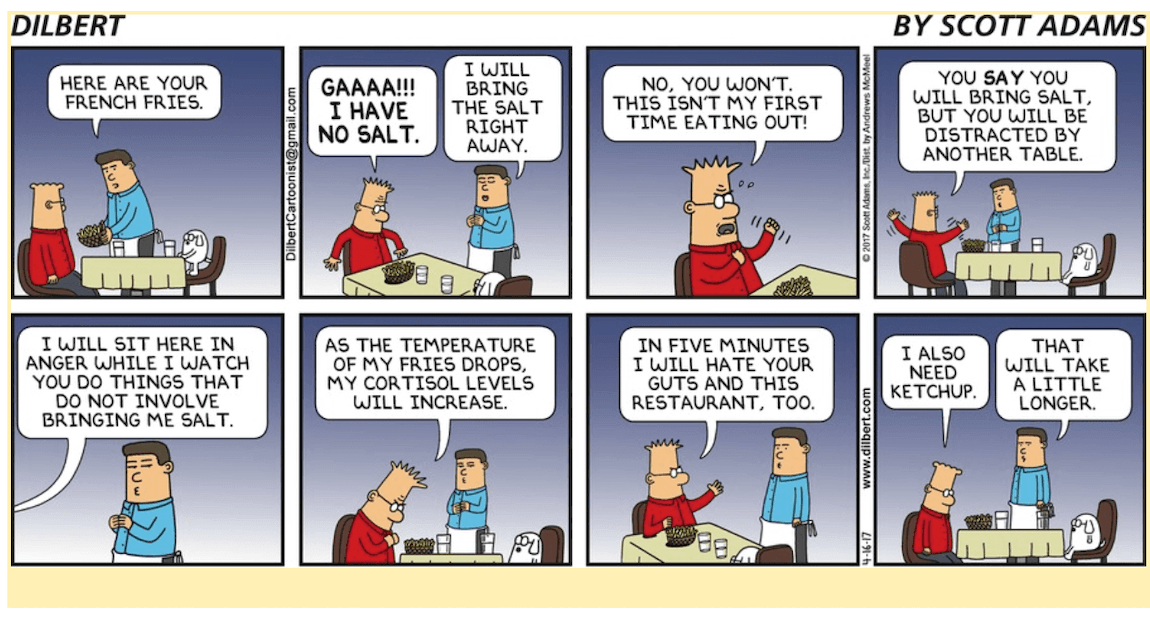As consumers of technology products (or really any product), we feel entitled to the best customer service available. As the old cliché goes, “the customer is always right.” With escalation paths just a click away, it’s easier than ever to report a poor customer experience and express displeasure via reviews and ratings. And dissatisfied customers users can quickly shift to a competitor’s application.
In this highly competitive market, companies are striving to strike the right balance between getting their core product right and offering a stellar end-to-end customer experience. And that’s what digital transformation is really about.
Service thinking
Imagine going to a restaurant. It’s not just the food we expect to be great during our visit, right? We also expect a pleasant ambiance, comfortable seating, and polite servers. A gratifying overall experience overall is what we’re looking for. It takes deep empathy and holistic thinking to be able to deliver a delightful customer experience (CX), typically referred to as customer service. In the context of a restaurant, I’m guessing this kind of “customer service thinking” (service thinking) is usually enforced by the restaurant owner/manager, or by the chef herself.

Service thinking goes beyond the product itself. If we apply this concept to the software-as-a-service (SaaS) products that we are using or building for others, that means we should be thinking beyond the core product functionality. In simple terms, developing and running a cloud SaaS product is much like running a restaurant. Teams must use holistic thinking to deliver a fantastic 360-degree customer experience. And much of this responsibility lies with the product manager.
SaaS-based examples
Most of us have consumed modern-day internet services like Amazon.com, ride-hailing services like Uber and Lyft, lodging services like Airbnb, or infrastructure services like Amazon Web Services (AWS) and Microsoft Azure. These are great examples of truly modern, cloud-native (born in the cloud) services that have shifted the paradigm for certain industries.
If you think about some of the user touch-points within these applications, you’ll notice several instances of service thinking. Below are just a few examples:
- Returning a product/item back to Amazon.com without any questions asked
- Reporting forgetting your personal belongings in your Uber/Lyft
- Making a purchase online, then picking up your item(s) in-store or curbside
- Automated, non-intrusive, patching of your database or applications in the cloud
These use cases hinge on delivering world-class customer experiences. Often, these involve identifying and automating complex user journeys and processes that are layered over the core product functionality to deliver delightful, pain-free experiences. As product managers, you may be directly or indirectly responsible for delivering a holistic customer experience. Some of you may already have to think end-to-end, especially if you run a business, a technology platform, or a program involving multiple stakeholders, while some others may be focused on delivering point solutions.
Additionally, holistic service thinking is a highly desirable attribute when delivering traditional purpose-built software for on-premise solutions as SaaS applications. Examples may include but are not limited to: accounting software, ERP systems, database management systems, financial applications, and productivity tools.
Regardless of which category you belong to, applying holistic service thinking goes a long way for everyone — your customers, product, internal stakeholders, and most importantly, your business. Service thinking should be a staple trait for all PMs. To that end, I’d like to share a framework that is quite powerful and has worked really well for me.
Frequently asked questions (FAQs)
Yes, FAQs! As trivial as they may sound, FAQs are an incredible tool for encouraging holistic thinking and keeping your customers and internal stakeholders at the center of your thought processes. In fact, it’s something that Amazon pioneered. By simply asking about the What, Why, How, Where, and How of your product, FAQs act as an effective starting point for service thinking. Also, FAQs are a tool that can be used at any point in the product/program lifecycle.
When writing FAQs, a best practice would be to segregate them into external FAQs and internal FAQs. External FAQs impact your customers and partners. On the other hand, internal FAQs impact your organizational stakeholders (sales, sales enablement, alliances, legal, security, tech support, etc.), and business processes. Before you start writing your FAQs, identify and list all your stakeholders, both external and internal. Then note down potential touchpoints for these sets of users within your product or program.
FAQs in action
Let’s look at an example. If you’re a B2B SaaS startup that is about to launch your MVP, one of your go-to-market strategies to acquire customers might be to offer a free trial. The free trial would be a perfect example of a program where you could apply holistic service thinking. Some examples of additional use cases or touchpoints for end users would include:
- Trial sign up
- Multi-factor authentication via SMS/Email
- Extending the trial
- Converting the trial to a paid subscription
- Email notifications to internal stakeholders
- Sending automated email campaigns
If we were to write sample external FAQs for these use cases, they would look something like the below:
- How do I sign up for the free trial?
- My one-time password/code has expired. What do I do?
- How can I convert my trial to a paid subscription?
- How do I make the most of the product during the trial period?
- What will happen to my data after the trial period?
Internal FAQs may include:
- How do we inform the sales team when a new customer signs up for a trial?
- How can the sales engineers assist the customer during the trial?
- What are the best usage metrics for evaluating the trial?
Start with questions
As you can see, it all starts with asking questions. Some may seem trivial and obvious, while others may take longer to answer. In any case, going through this exercise will encourage you to think about all your stakeholders, both internal and external. It’s totally fine if you don’t address all of the questions right away — you’ll get there eventually.
FAQs aid in expanding your holistic thinking and help bring all your stakeholders into the product development process from the very beginning. As a result, your team will be better able to address unknowns and validate your assumptions, especially in areas like security, governance, and/or legal. With this model and with some practice, your stakeholders will automatically have skin in the game, which goes a long way toward delivering stellar experiences that customers love!


